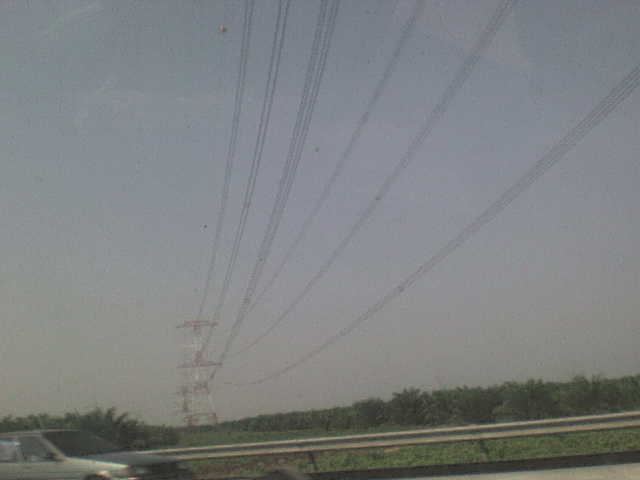 | ||
National Grid, Malaysia (Malay: Grid Nasional) is the high-voltage electric power transmission network in Peninsular Malaysia. It is operated and owned by Tenaga Nasional Berhad (TNB) by its Transmission Division. There are two other electrical grids in Sabah and Sarawak operated by Sabah Electricity Sdn Bhd (SESB) and Sarawak Energy Berhad (SEB) respectively.
Contents
- History
- Transmission system
- Connection to Thailand
- Connection to Singapore
- Power generation
- Distribution level
- Major incidents
- References
The system spans the whole of Peninsular Malaysia, transporting electricity in bulk from power generators owned by TNB and Independent Power Producers (IPPs) to distributors. The grid also transports directly to large industrial customers, such as steel mills and fertilizer plants.
History
The beginnings of the National Grid was slowly taking shape in 1964 when the Bangsar Power Station was connected to the Connaught Bridge Power Station, with the line subsequently extended to Malacca.
By 1965, a plan was set to connect the electricity generating plants that were spread out all over the country. Plants identified to be linked were located at Paka in Terengganu, Temengor, Kenering, Bersia and Batang Padang in Perak, Connaught Bridge, Kapar and Serdang in Selangor, Cameron Highlands in Pahang, Perai in Penang, Port Dickson in Negeri Sembilan, Pergau in Kelantan, Pasir Gudang in Johor and in Malacca.
The central area network with Connaught Bridge Power Station in Klang was the precursor of the energy grid; it also tapped into the Cameron Highlands Hydro scheme from the Sultan Yussuf Power Station, and was extended into a western network. Late in the 1980s, the loop was finally complete with the placement of Kota Bharu within the grid.
Transmission system
More than 420 transmission substations in the Peninsular Malaysia, with a total installed capacity of 105,305 MVA, are linked together by approximately 21,000 circuit-kilometers of overhead lines and underground cables operating at 132, 275 and 500 kilovolts (kV). The 500 kV transmission system is the single largest transmission system to be ever developed in Malaysia. Begun in 1994, Phase 1 involved the design and construction of the 500kV overhead lines from Gurun, Kedah in the North along the west coast to Kapar, in the central region and from Pasir Gudang to Yong Peng in the south of Peninsular Malaysia.
The total distance covered for the 500 kV transmission lines is 784 circuit-km and the 275 kV portion is 9,257 circuit-km as of February 2017. To cater for the new plant up of generators, namely 3,100 MW Janamanjung Power Plant in the west cost, 372 MW Ulu Jelai Hydro Electric Power Plant in the east cost, and 4,100 MW Tanjung Bin Power Plant in the south, the 500 kV transmission system was extended from Bukit Tarek to Yong Peng via interconnection allows for electricity of Ayer Tawar, Tapah, Bentong South and Lenggeng. The completion of this interconnection allows for electricity transmission to the load centre, which is located in the Klang Valley area of Peninsular Malaysia.
A project involving laying a 730 km high-voltage direct current transmission line and a 670 km undersea cable for the 2,400-megawatt Bakun hydroelectric dam has been considered. This may connect all three of Malaysia's electric utility companies with state grids: Tenaga Nasional Berhad (TNB), Sarawak Energy Berhad (SEB) and Sabah Electricity Sdn Bhd (SESB). Many of Sabah and Sarawak's generation plants are still not interconnected to a grid.
Connection to Thailand
The National Grid is interconnected in the north to Electricity Generating Authority of Thailand (EGAT)'s transmission system via the 300 kV HVDC interconnection of 300MV capacity and 132 kV HVAC double circuit overhead line of 90MW capacity each, linking Bukit Ketri-Chuping in the state of Perlis with Sadao, Sadao in Thailand.
Connection to Singapore
In the South of Malaysia, the National Grid is connected to the transmission system of Singapore Power Limited (SP) at Senoko via two 230 kV submarine cables with a transmission capacity of 200 MW each.
Power generation
Power generation capacity connected to the Malaysian National Grid is 22,858 megawatt, with a maximum demand of 17,788 megawatt as of April 2016 according to Suruhanjaya Tenaga. The generation fuel mix in peninsular is 45.55% gas, 50.23% coal, 3.59% hydro and 0.63% from other forms of fuel.
Distribution level
Distribution lines of 33 kV, 22 kV, 11 kV, 6.6 kV and 415/240 volt in the Malaysia distribution network connect to the National Grid via transmission substations where voltages are stepped down by transformers.
